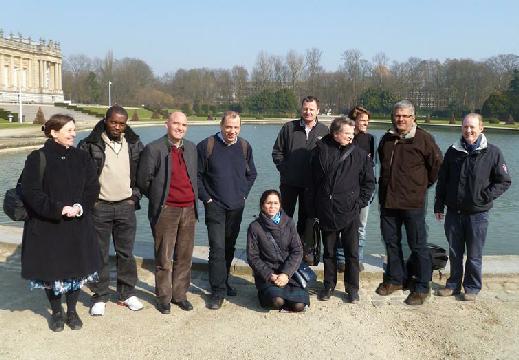Projects
CHOLTIC
Cholera is one of the deadliest diseases in Africa. Cholera outbreaks reappeared in the area of the African Rift in the late 70’s while strong signals of climate changes were noted (Lipp et al.,2002; O’Reilly et al., 2003). It is suspected that climate change has triggered cholera epidemics through a change of lake condition, biodiversity host organisms. The African Rift is pointed as an area of propagation-source of Cholera (Bompangue et al., 2008a). A link between cholera, phytoplankton blooms and copepods zooplankton was demonstrated in Asia by Colwell et al. (1996). Great lakes such as Lake Tanganyika are highly suspected of playing a role as a reservoir of the cholera bacteria while human infection and movement propagate the disease inland.
Environmental and epidemiological data in the Rift Lake area were collected independently between 2002 and 2006 by CLIMFISH, a BELSPO project (MODIS satellite data) and by Bompangue et al. (2008) in RD Congo (epidemiologic data). Cross analyses unexpectedly highlighted simultaneous phytoplankton blooms and cholera outbreaks, a relation only shown in the ocean so far (Colwell et al.,1996). The comparable periodicities of blooms and cholera cases support a “lake reservoir hypothesis” and climate induced changes that we propose to test.
We aim to detail environmental conditions triggering cholera outbreaks at Lake Tanganyika in a interdisciplinary study:
(1) In situ monitoring: Previous data were acquired independently. For the CHOLTIC project, an integrated 3 years simultaneous field monitoring of meteorology, limnology, phytoplankton, zooplankton, fish abundance, fishermen and traders movements is necessary. Epidemiological statistics of cholera cases and fatalities added to a bacteriological monitoring (human, lake water and plankton) will be analysed in 3 stations. Standardized procedure including comparable step time will be used.
(2) Remote sensing. Previous CLIMLAKE and CLIMFISH projects showed that remote sensing is an efficient tool to get spatial and synoptic limnological information at Lake Tanganyika. We will produce time series of daily images of chlorophyll a (phytoplankton and indirectly zooplankton proxy), K490 (light attenuation coefficient) from MODIS-TERRA and AQUA and SST (lake surface temperature) from AVHRR satellites using validated procedures (Horion et al, 2010) for the period 2000-2014. Medium resolution satellite images will allow the environmental study of cholera epidemics.
(3).Eco-hydrological modelling will investigate links between climate, upwelling of nutrient rich water and occurrence of planktonic blooms at time of cholera outbreaks. The interannual variation in local climate and planktonic blooms related to gobal indicators such as ENSO will be studied for predictability analysis. This should be useful for early warning detection in the whole region of Lake Tanganyika (including Lake Kivu). Numerical modelling will also be used to study the historical changes in lacustrine conditions in relation to cholera outbreaks.
(4) Microbiology: microbiological confirmation will be performed in laboratories of INRB at Kinshasa.
(5) Genetic: characterisation and identification of cholera strains genotypes and mass spectra phenotypes will be carried out at AP-HM (Marseille). This will be helpful to understand the pathways of cholera outbreaks.
(6) Data analysis: The spatio-temporal relationships between environmental factors and health data will be explored by multivariate statistics integrating spatial and time series analysis results. A GIS (geographical information system) will contribute to the integration of interdisciplinary data. Correlation between climate, oceanic, limnological and epidemiologic data will be investigated as they could contribute to early warning of cholera outbreaks.
(7) Epidemiological modelling: A feasibility study will be conducted, so as to determine whether preliminary epidemiological models (Koelle and Pascual, 2004; Koelle et al., 2005, Keeling and Rohani, 2008) can be of use for representing past cholera outbreaks and, possibly, predict future ones.
This interdisciplinary project will involve specialists in each concerned topics to investigate the environmental factors favouring the reservoir-hosts as well as outbreak and spatial propagation of V. cholerae for the first time in a freshwater environment. The possible links with climate change and global indices could help in designing early warning methods applicable to cholera outbreaks, a crucial health issue in Africa and worldwide.
PARTNERS
Dr Pierre Denis PLISNIER
CHOLTIC coordinator
Musée Royal de l'Afrique Centrale
Leuvensesteenweg 13
3080 Tervuren
02/769.54.05
0478 96 14 23
pierre-denis.plisnier@africamuseum.be
http://www.africamuseum.be/home
http://www.africamuseum.be/museum/research/natural-sciences/index_html
Dr Yves CORNET
Université de Liège
allée du 6 Août 17
4000 Liège
04/366.53.71
ycornet@ulg.ac.be
http://www.geo.ulg.ac.be/cms/
http://www.ulg.ac.be/cms/c_5000/accueil
Dr Christine COCQUYT
Nationale Plantentuin van België
Domein van Bouchout
1860 Meise
02/260.09.41
c.cocquyt@br.fgov.be
http://www.br.fgov.be/PUBLIC/GENERAL/index.php
Dr Jan JACOBS
Instituut voor Tropische geneeskunde
Nationalestraat 155
2000 Antwerpen
tel 03/247.66.30
fax 03/247.64.40
jjacobs@itg.be
http://www.itg.be/itg/
Dr Renaud PIARROUX
Université de la Méditérranée
Assistance Publique Hôpitaux de Marseille
Tel : + 33 491 38 75 58
Renaud.PIARROUX@ap-hm.fr
http://www.univmed.fr/
http://www.ap-hm.fr/aphm/fr/site/accueil.asp
Dr Didier BOMPANGUE
Direction de la Lutte Contre la Maladie,
Ministère de la Santé Publique,
39 Avenue de la Justice Kinshasa, Gombe RD Congo
joellebop@yahoo.fr
Tel : ++ 33 6 84 364 755 (France)
Dr Patrick GIRAUDOUX
Unité de recherche Chrono environnement, UMR 6249
Franche-Comté University, 25030, Place Leclerc, Besançon, Cedex, France.
patrick.giraudoux@univ-fcomte.fr
Phone: ++ 33 (0)3 81 66 57 45
Fax : ++ 33 (0)3 81 66 57 97
http://chrono-environnement.univ-fcomte.fr/spip.php?article1028
http://www.univ-fcomte.fr/
Dr Eric DELEERSNIJDER
Institute of Mechanics, Materials and Civil Engineering (iMMC)
& Earth and Life Institute (ELI)
Université catholique de Louvain
4 Avenue G. Lemaître, B-1348 Louvain-la-Neuve, Belgium
Tel: +32-(0)10.47.23.63 or +32-(0)10.47.23.50 or +32-(0)493.248.829
Fax: +32-(0)10.47.21.80
eric.deleersnijder@uclouvain.be
http://www.ericd.be
http://www.climate.be/slim
http://www.uclouvain.be
FUNDING
BELSPO
Politique scientifique fédérale
Federaal Wetenschapsbeleid
Belgian Federal Science Policy Office
Föderale Wissenschaftspolitik
http://www.belspo.be/belspo/
Principal investigator:
- Pierre-Denis Plisnier
Dates:
2010 2015Museum staff:
- Pierre-Denis Plisnier
External collaborators:
Dr Pierre-Denis PLISNIER (MRAC, coordinateur)Dr Yves CORNET (Université de Liège)
Dr Christine COCQUYT (Nationale Plantentuin van België)
Dr Jan JACOBS (Instituut voor Tropische geneeskunde )
Dr Renaud PIARROUX (Université de la Méditérranée)
Dr Eric DELEERSNIJDER (Université catholique de Louvain)
Dr Didier BOMPANGUE (Université de Kinshasa)
Dr Patrick GIRAUDOUX (Université de Franche Comté)
Dr MUYEMBE (INRB, Kinshasa)
